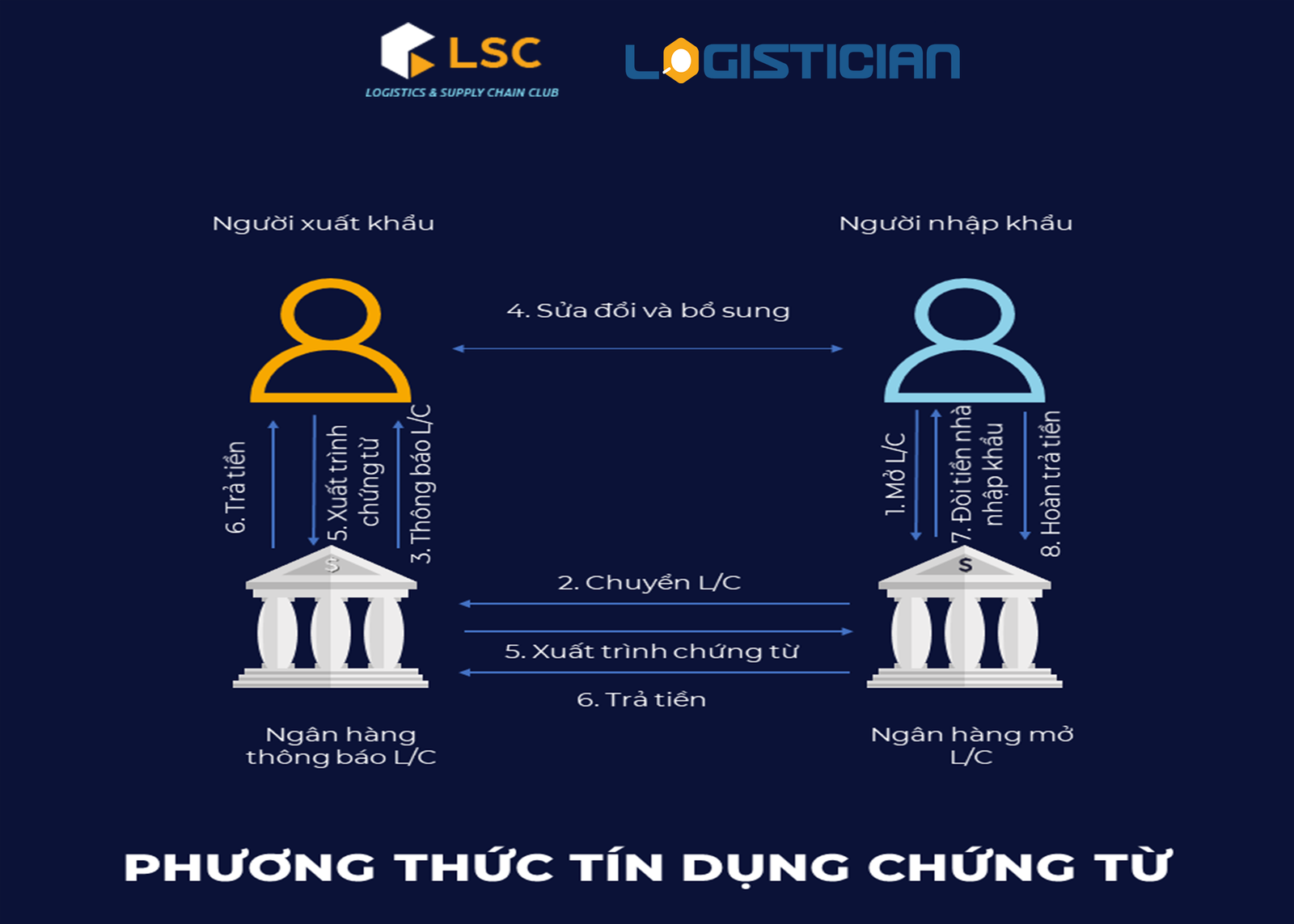Letter of Credit – L/C
Payment via a letter of credit is used quite commonly. It is an agreed payment method in which a bank (the bank that opens the credit), at the request of a customer (the applicant for credit), will pay to a third party or pay any person at the behest of such third party (the beneficiary) or shall pay, accept, purchase a draft issued by the beneficiary or authorize another bank to pay, accept or purchase the bill of exchange voucher upon presentation of all prescribed documents and all conditions set forth are fulfilled.
Therefore, to a certain extent, documentary credit is a payment method that balances the interests of both exporters and importers and resolves conflicts of distrust of both parties.

However, in the process of applying, the parties should pay attention to the following legal characteristics of the letter of credit:
- L/C is formed based on the underlying contract, but it is completely independent of the contract when it is issued. The bank opening the letter of credit and other banks participating in the letter of credit operation only follow the letter of credit provisions.
- Letter of credit is a “type of sale of documents”. According to Article 5 of UPC600: “Banks transact based on documents and not with goods, services or other performance to which the documents relate”.
As such, the bank is obligated to pay the exporter when he/she presents documents by the terms and conditions specified in the L/C. The bank is not allowed to use the reason that the buyer has not received the goods to refuse to pay if the documents presented by the seller are following the terms and conditions specified in the L/C.
Authority to Purchase – A/P
Authority to purchase letter is a letter written by the buyer’s home bank to an overseas bank at the request of the buyer requesting this bank to purchase the drawee’s draft on behalf of the buyer. The correspondent bank pays the bill of exchange based on the terms of the purchase entrustment letter, the buyer’s bank collects the buyer’s money and delivers the documents to them.
This method exists because rich countries, when using the documentary credit payment method, often use the excuse that the banks of poor countries are not trustworthy enough, so they cannot guarantee their letters of credit to be open to traders. exports in rich countries. Therefore, that bank has to deposit capital first at a rich country bank before it can open a letter of credit.

The purchase entrustment letter differs from the documentary credit method in the following points:
- Using authority to purchase letter to buy is not based on the credit of the buyer’s bank, but requires a foreign correspondent bank to guarantee payment of the seller’s draft, so the buyer’s bank must bring an amount of foreign currency equivalent to the amount of draft deposited in a foreign bank. Thus, this method is not based on secured credit but guaranteed cash (escrow).
- In documentary credit, the seller can bring the bill of exchange to any bank at a discount, but the authority to purchase, since the person paying the bill of exchange is the importer, the seller can only bring the bill of exchange to the advising bank entrusted to buy the bill of exchange to receive the money.
- In documentary credit, when the seller wants to receive money immediately at the advising bank or discount the draft to a certain bank, it must bear the discounting cost. In contrast, in authority to purchase, when the seller brings the bill of exchange to the advising bank, which must pay the bill, the seller does not have to pay any discount.
Letter of Guarantee
Here, the buyer’s bank, at the request of the buyer, writes to the seller a letter, called a “guarantee of payment” letter, which guarantees to pay for the goods after the seller’s goods have arrived at the place where specified by the parties.
Letter of guarantee differs from the letter of credit and the authority to purchase in that this method is based on the goods to pay, and the two methods above are based on the documents to pay.

Payment by letter of guarantee has 3 types:
- Goods to pay: When the goods arrive and unloaded, the bank opens a letter of payment guarantee or its correspondent bank at the port of entry for the overseas agent to pay the seller. It is also stipulated that if the overseas agent does not receive the payment notice from the domestic bank, a few days after the seller presents to the bank a certificate of the charter company certifying the arrival of the goods and unloading, the bank automatically pays the seller. This method of payment applies to relatively reliable sellers and to goods that do not need to be tested.
- After testing, paying: After the goods arrive at the wharf and are tested if the goods are in accordance with the specifications, quantity and quality, the buyer will pay. This method of payment is usually applied to items that are difficult to judge from the outside or are in original condition.
- Incoming goods pay a part, the rest will be paid after the test results are available. This method ensures that the goods arrive at the wharf safely, with the right quality and type, proactively in the payment time, and without any capital stagnation. Its disadvantage is that the price of goods is high because sellers are disadvantaged, so they often raise the price of goods.
Phan Quyen
Read more: Payment Methods Used In International Trade (Part 1)













